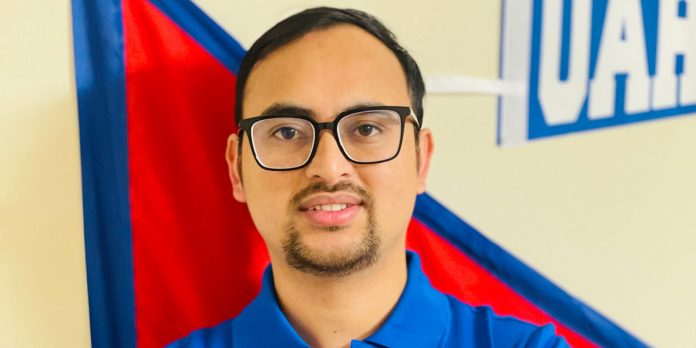HUNTSVILLE – Ashok Silwal, a doctoral candidate and graduate research assistant at the University of Alabama in Huntsville, has been chosen to receive a NASA Future Investigators in NASA Earth and Space Science and Technology (FINESST) scholarship to study stream interaction regions (SIRs) in the heliosphere.
SIRs accelerate energetic particles, impacting the interaction between the solar wind and the Earth’s magnetosphere. How energetic particles are generated in the solar wind is a fundamental question in heliophysics. FINESST awards are research grants for up to three years and $50,000 per year.
“SIRs are very large-scale structures formed by the interaction between two different solar wind streams – usually as a faster stream catches up with a slower stream from behind,” Silwal said. “As the structure rotates with the sun at the solar spin speed, it is frequently referred to as ‘corotating’ interaction regions (CIRs). Energetic particles are often observed at or near SIRs and are a part of what we call space weather – conditions in space that can impact satellites, astronauts and even technology on Earth, such as GPS systems and power grids.
“How these particles are generated is still an open question, despite many theories being proposed.”
SIRs tend to dominate large-scale solar wind dynamics, and the interaction of SIRs with the magnetosphere causes most geomagnetic storms during the minimum of the solar cycle.
“My specific research is the connection between turbulence and energetic particles,” Silwal said. “The solar wind is naturally embedded with turbulence, but what’s more interesting is how turbulence is processed by the SIRs. Using data measured by spacecraft, we can observe how properties of turbulence change in different parts of SIR structure. These changes can then be correlated to variations in the measured energetic particle intensity. I’ve found that, for SIR-accelerated particles, the increase in turbulence amplitude within the SIR may be an important factor.”
Most existing knowledge of SIRs comes from single point observations near the Earth, but data from different locations are now available, thanks to recent missions such as Parker Solar Probe and Solar Orbiter.
“What is special about this project is the emphasis on multi-point observations,” said Dr. Lingling Zhao, an assistant professor in the UAH Department of Space Science and Silwal’s advisor. “Parker Solar Probe and Solar Orbiter have provided new insights by measuring fields and particles at different locations within Earth’s orbit around the sun. By comparing data from the new missions with other data measured near Earth, Ashok’s project will be able to address how fast and slow solar wind stream interactions affect turbulence and energetic particles.”
“Since SIRs are large-scale structures, having multiple vantage points is extremely valuable,” Silwal said. “What’s interesting about them is that they are always present in the solar wind, unlike other more transient phenomena like solar flares. And since they corotate with the sun, the same SIR structure can sweep by the Earth repeatedly every month or so. Therefore, SIRs can be especially important during solar minimum when solar activities are weak.
“In this work we’ll also learn more about the physical mechanisms that accelerate particles and try to understand which mechanism(s) is consistent with observational results.”
Don’t miss out! Subscribe to our email newsletter to have all our smart stories delivered to your inbox.



